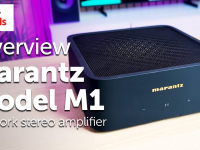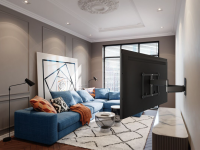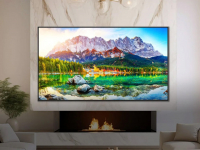
After the success of the LG B6 series from 2016, I couldn’t wait to get my hands on the new B7…
The B7 was announced as the “entry level” of this years OLED offerings from LG. Entry level in appearance only so it would seem, as LG have confirmed that all of their 2017 OLEDs have exactly the same panel and picture quality. Not similar, exactly the same. So whether it’s their top of the range 78″ wallpape W7, or the aforementioned 55″ B7, the picture quality will not differ. This isn’t to take anything away from how the B7 looks, as it’s still a sight to behold.
Measuring just 49mm at its deepest point, it just oozes class. It is a visually stunning TV with hardly any bezel at all. Not to mention a dazzling silver stand, which wouldn’t look out of place at a fine dining restaurant. Want to wall mount it for an almost picture like effect? Not a problem… just use any standard VESA 300mm x 200mm bracket and you’re good to go.
Have a peek around the back and you’ll see 4 HDMI connections; all of which are HDCP 2.2 complaint. 3 USBs are also included. These allow video playback as well as the facility to record from the in-built Freeview and Freesat tuners. Sadly no component on this year’s models, so anyone looking to hook up an early 90’s game console will have to do without.
As there’s no option for a Super Nintendo, you’ll have to make do with something else. How about the biggest leap picture quality on a TV I’ve seen since the Pioneer Kuro? Will that do? It should, because it’s incredible. Other manufacturers have only just started readily producing OLED screens for the mass market, but LG have been doing this for a few years now. They’ve used their experience of producing OLED screens and taken picture quality to another level. From the very first Full HD set readily available, the 55EA980 in 2014, right through to the B7, they’ve continued on this never ending quest to find picturesque perfection. And this is the closest I’ve seen yet.
What creates this quite astonishing image quality is the ability for each individual pixel to create its own light. There’s no relying on lighting behind the panel or at the sides with OLEd technology. Each pixel can therefore be turned off and on more precisely. Because of this, blacks are exactly that. Black. They’re not dark grey. There’s no light bleed. Just black. They’ve also added a new polariser layer for good measure to help with…. you’ve guessed it. Black levels.
One thing I always seem to read about is how OLED TVs can’t reach the same brightness as LED technology. This is true to a degree as this panel maxes out at 1000 nits, whereas LED TVs can reach a peak brightness of up to 2000 nits. Numbers can be deceiving as because of the level of black that this set can produce, it just doesn’t need to go any brighter. LG have said that the 2017 range is 25% brighter than last years models and it definitely rings true.
Colours are vibrant, crystal clear and there’s no bleeding throughout the whole panel. Everything just seems so natural and life like. When playing the newly released Planet Earth 2 in 4K it almost seems unfair to compare to anything I’ve seen before. There’s no judder, the camera panning is as good as it gets and every single detail of this wonderful documentary is on view for you to see. This is the best thing I’ve EVER seen on a TV. Outstanding.
Switch to some Freesat HD via the in-built tuner and everything just works. The picture is well rounded and the detail in the image is something I didn’t expect. It even does a fairly decent job for standard definition content, which can’t be said for many sets.
The B7 handles anything I throw at it with ease. It iss HDR 10 compatible and is ready for Dolby Vision. There’s HLG (hybrid-log gamma) support for upcoming over-the-air releases, and just to top it off, it’s also able to decode Dolby Atmos. Jack of all trades master of… well… all of them, to be honest.
LG have really aimed high and haven’t disappointed. They’ve even updated their already capable Smart TV platform slightly (web os 3.5) to make it all a bit smoother and more responsive. These will include things like Amazon Prime, BBC iPlayer, ITV Hub and All4.
This TV needs to be seen to be believed. Give us a call at your local Richer Sounds store and see what all the fuss is about.
Shop with Richer Sounds today.
Author: Bradley, Plymouth Store





